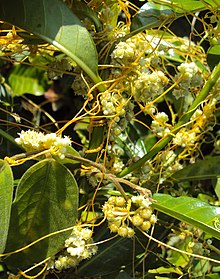Cuscuta chinensis
| Cuscuta chinensis | |
|---|---|

| |
| Scientific classification | |
| Kingdom: | Plantae |
| Clade: | Tracheophytes |
| Clade: | Angiosperms |
| Clade: | Eudicots |
| Clade: | Asterids |
| Order: | Solanales |
| Family: | Convolvulaceae |
| Genus: | Cuscuta |
| Species: | C. chinensis
|
| Binomial name | |
| Cuscuta chinensis | |
| Synonyms[1] | |
| |
Cuscuta chinensis Lam. is a stem holoparasite vine in the family Convolvulaceae.[2][3] It was first described in China in 1786.[4]
Description
C. chinensis is a thin, yellow vine lacking leaves or roots.[2] It produces glomerulate to dense paniculiform inflorescences composed of white-cream 5-merous flowers that are very small, have two styles with capitate stigmata, and produce 3–4 obovoid seeds per capsule.[3][5] Its pollen grains are small, colporate, and covered by a finely reticulate ektexine.[6]
C. chinensis var. chinensis has been observed to flower from June–October, December–March, and February–May. It is found throughout western Asia, tropical Asia, eastern Asia, and Australasia[3] at latitudes between 20° N and 50° N.[2] Specimens of Cuscuta campestris are occasionally mislabeled as C. chinensis; the two species can be differed by C. chinensis's carinate calyx lobes, incurved but not inflexed corolla lobes, and dehiscent seed capsule.[3]
C. chinensis var. applanata flowers from June to October and is found in Mexico and the southwestern US.[3]
Use in traditional medicine
C. chinensis is used medicinally in many Asian countries, including China, Korea, Pakistan, Vietnam, India, Thailand, Nepal, and Inner Mongolia.[7][8] Biochemical analysis has found at least 93 pharmacologically active phytochemicals present in C. chinensis correlated with its use as an anti-inflammatory agent, anti-aging agent, pain reliever, or aphrodisiac.[9]
References
- ^ "Cuscuta chinensis Lam". The Plant List. Retrieved 2021-11-12.
- ^ a b c Ren Z, Zagortchev L, Ma J, Yan M, Li J (2020). "Predicting the potential distribution of the parasitic Cuscuta chinensis under global warming". BMC Ecol. 20 (1): 28. Bibcode:2020BMCE...20...28R. doi:10.1186/s12898-020-00295-6. PMC 7210669. PMID 32386506.
{{cite journal}}: CS1 maint: multiple names: authors list (link) - ^ a b c d e Costea M, Spence I, Stefanović S (2011). "Systematics of Cuscuta chinensis species complex (subgenus Grammica, Convolvulaceae): evidence for long-distance dispersal and one new species". Org Divers Evol. 11 (5): 373–386. doi:10.1007/s13127-011-0061-3. S2CID 33326805.
{{cite journal}}: CS1 maint: multiple names: authors list (link) - ^ Lamarck J, dePoiret J (16 Oct 1786). "Cuscuta chinensis Lam". Encyclopedie Methodique. Botanique ... Paris. 2 (1): 229.
- ^ Park I, Song JH, Yang S, Kim WJ, Choi G, Moon BC (2019). "Cuscuta Species Identification Based on the Morphology of Reproductive Organs and Complete Chloroplast Genome Sequences". Int J Mol Sci. 20 (11): 2726. doi:10.3390/ijms20112726. PMC 6600609. PMID 31163646.
{{cite journal}}: CS1 maint: multiple names: authors list (link) - ^ Liao, Gwo-Ing; Chen, Ming-Yih; Kuoh, Chang-Sheng (2005). "Pollen morphology of Cuscuta (Convolvulaceae) in Taiwan". Bot Bull Acad Sin. 46: 75–81.
- ^ O'Neill, A.R.; Rana, S.K. (2019). "An ethnobotanical analysis of parasitic plants (Parijibi) in the Nepal Himalaya". Journal of Ethnobiology and Ethnomedicine. 12 (14): 14. doi:10.1186/s13002-016-0086-y. PMC 4765049. PMID 26912113.
- ^ Wurchaih; Huar; Menggenqiqig; Khasbagan (2019). "Medicinal wild plants used by the Mongol herdsmen in Bairin Area of Inner Mongolia and its comparative study between TMM and TCM". Ethnobiology Ethnomedicine. 15 (32): 32. doi:10.1186/s13002-019-0300-9. PMC 6609360. PMID 31269968.
- ^ Donnapee S, Li J, Yang X, Ge AH, Donkor PO, Gao XM; et al. (18 November 2014). "Cuscuta chinensis Lam.: A systematic review on ethnopharmacology, phytochemistry and pharmacology of an important traditional herbal medicine". J Ethnopharmacol. 157: 292–308 292–308. doi:10.1016/j.jep.2014.09.032. PMID 25281912.
{{cite journal}}: CS1 maint: multiple names: authors list (link)
